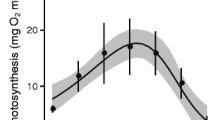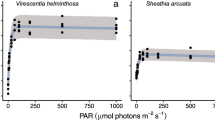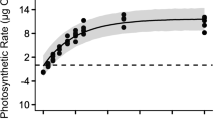Abstract
The effect of irradiance and temperature on the photosynthesis of two Japanese agarophytes, Gelidium elegans and Pterocladiella tenuis (Gelidiales), was determined using dissolved oxygen sensors and pulse amplitude modulated (PAM) fluorometry. Gross photosynthesis and dark respiration rates were determined over a range of temperatures (8–36 °C). The highest gross photosynthetic rates were 40.3 and 37.0 mg O2 g −1ww min−1 and occurred at 24.3 and 25.5 °C [95 % Bayesian credible interval (BCI) 20.7–28.0 and 23.4–28.3 °C], respectively. The dark respiration rate in G. elegans and P. tenuis increased with increasing temperature at a rate of 0.10 and 0.31 mg O2 g −1ww min−1 °C−1 , respectively. Modeling the net photosynthesis–irradiance (P–E) responses of G. elegans and P. tenuis at 20 °C revealed that the net photosynthetic rates quickly increased at irradiance levels below the estimated saturation irradiance of 88 and 83 µmol photons m−2 s−1, with a compensation irradiance of 14 and 19 µmol photons m−2 s−1, respectively. The highest value of the maximum effective quantum yield (Φ PSII) occurred at 20.1 °C (BCI 18.9–21.5 °C) and 21.3 °C (BCI 20.2–22.5 °C) for G. elegans and P. tenuis and was 0.49 and 0.45, respectively. These optimal temperatures of Φ PSII were relatively lower than those determined by the photosynthesis–temperature model of oxygen evolution. The temperature response of these species indicates that they are probably well adapted to the current range of seawater temperatures in the study site but that they are near the boundary of their tolerable limits.



Similar content being viewed by others
References
Ohno M, Largo DB (1998) The seaweed resources of Japan. In: Critchley AT, Ohno M (eds) Seaweed resources of the World. Japan International Cooperation Agency (JICA), Yokosuka, pp 1–14
Zemke-White WL, Ohno M (1999) World seaweed utilisation: an end-of-century summary. J Appl Phycol 11:369–376
Fujita D (2004) Gelidiales. In: Ohno M (ed) Biology and technology of economic seaweeds. Uchida Rohkakuho, Tokyo, pp 201–225 (in Japanese)
Akatsuka I (1986) Japanese Gelidiales (Rhodophyta) especially Gelidium. In: Barnes H, Barnes M (eds) Oceanography and marine biology—an annual review, vol 24. Aberdeen University Press, Aberdeen, pp 171–263
Yoshida T (1998) Marine algae of Japan. Uchida Rokakuho Publishing, Tokyo (in Japanese)
Shimada S, Horiguchi T, Masuda M (2000) Confirmation of the status of three Pterocladia species (Gelidiales, Rhodophyta) described by K. Okamura. Phycologia 39:10–18
Shimada S, Masuda M (2002) Japanese species of Pterocladiella Santelices et Hommersand (Rhodophyta, Gelidiales). In: Abbott IA, Mcdermid KJ (eds) Taxonomy of economic seaweeds with reference to some Pacific species, vol 8. California Sea Grant College, La Jolla, pp 167–181
Shimada S, Masuda M (2003) Reassessment of the taxonomic status of Gelidium subfastigiatum (Gelidiales, Rhodophyta). Phycol Res 51:271–278
Yoshida T, Yoshinaga K (2010) Checklist of marine algae of Japan (revised in 2010). Jpn J Phycol 58:69–122 (in Japanese)
Japanese Ministry of Environment (1994) Fourth national survey on the natural environment. Biodiversity center of Japan, Ministry of Environment, Fujiyoshida. Available at: http://www.biodic.go.jp/english/J-IBIS.html (in Japanese)
Japan Metrological Agency (2013) Long-term trends in sea surface temperature (Northern East China Sea, Japan). Available at: http://www.data.kishou.go.jp/kaiyou/db/nagasaki/nagasaki_warm/nagasaki_warm_areaC.html#title (in Japanese)
Japan Metrological Agency (2011) Sea surface temperature in Japan. Available at: http://www.data.kishou.go.jp/kaiyou/db/kaikyo/knowledge/sst.html (in Japanese)
Shimabukuro H, Higuchi F, Terada R, Noro T (2007) Seasonal changes of two Sargassum species: S. yamamotoi and S. kushimotense (Fucales, Phaeophyceae) at Shibushi Bay, Kagoshima, Japan. Nippon Suisan Gakkaishi 73:244–249 (in Japanese)
Shimabukuro H, Terada R, Sotobayashi J, Nishihara GN, Noro T (2007) Phenology of Sargassum duplicatum (Fucales, Phaeophyceae) from the southern coast of Satsuma Peninsula, Kagoshima, Japan. Nippon Suisan Gakkaishi 73:454–460 (in Japanese)
Tsuchiya Y, Sakaguchi Y, Terada R (2011) Phenology and environmental characteristics of four Sargassum species (Fucales): S. piluliferum, S. patens, S. crispifolium, and S. alternato-pinnatum from Sakurajima, Kagoshima Bay, southern Japan. Jpn J Phycol 59:1–8 (in Japanese)
Watanabe Y, Nishihara GN, Tokunaga S, Terada R (2014) The effect of irradiance and temperature responses and the phenology of a native alga, Undaria pinnatifida (Laminariales), at the southern limit of its natural distribution in Japan. J Appl Phycol. doi:10.1007/s10811-014-0264-z
Watanabe Y, Nishihara GN, Tokunaga S, Terada R (2014) The effect of irradiance and temperature on the photosynthesis of a cultivated red alga, Pyropia tenera (=Porphyra tenera), at the southern limit of distribution in Japan. Phycol Res. doi:10.1111/pre.12053
Tanaka T, Yoshimitsu S, Imayoshi Y, Ishiga Y, Terada R (2013) Distribution and characteristics of seaweed/seagrass community in Kagoshima Bay, Kagoshima Prefecture, Japan. Nippon Suisan Gakkaishi 79:20–30 (in Japanese)
Ogata E, Matsui T (1965) Photosynthesis in several marine plants of Japan as affected by salinity, drying and pH, with attention to their growth habitats. Bot Mar 8:199–217
Yokohama Y (1973) A comparative study on photosynthesis temperature relationships and their seasonal changes in marine benthic algae. Int Rev Ges Hydrobiol Hydrogr 58:463–472
Maegawa M, Sugiyama A (1995) Relationship between heat tolerance and the vertical distribution of intertidal algae. Suisanzoshoku 43:429–435 (in Japanese)
Katada M (1955) Studies on the propagation of Gelidium. J Shimonoseki College Fish 5:1–87 (in Japanese)
Yamazaki H (1962) Studies on the propagation of Gelidiaceous algae. Bull Izu Branch Shizuoka Prefect Fish Exp Stn 19:1–92 (in Japanese)
Baba M (2010) Effects of temperature, irradiance and salinity on the growth of Gelidium elegans (Rhodophyta) in laboratory culture. Rep Mar Ecol Res Inst 13:61–74 (in Japanese)
Gómez I, Figueroa FL (1998) Effects of solar UV stress on chlorophyll fluorescence kinetics of intertidal macroalgae from southern Spain: a case study in Gelidium species. J Appl Phycol 10:285–294
Mercado JM, Carmona R, Niell X (1998) Bryozoans increase available CO2 for photosynthesis in Gelidium sesquipedale (Rhodophyceae). J Phycol 34:925–927
Silva J, Santos R, Serôdio J, Melo RA (1998) Light response curves for Gelidium sesquipedale from different depths, determined by two methods: O2 evolution and chlorophyll fluorescence. J Appl Phycol 10:295–301
Schmidt EC, dos Santos RW, de Faveri C, Horta PA, de Paula Martins R, Latini A, Ramlov F, Maraschin M, Bouzon ZL (2012) Response of the agarophyte Gelidium floridanum after in vitro exposure to ultraviolet radiation B: changes in ultrastructure, pigments, and antioxidant systems. J Appl Phycol 24:1341–1352
Ralph PJ, Gademann R (2005) Rapid light curves: a powerful tool to assess photosynthetic activity. Aquat Bot 82:222–237
Cosgrove J, Borowitzka MA (2011) Chlorophyll fluorescence terminology: an introduction. In: Suggett DJ, Prášil O, Borowitzka MA (eds) Chlorophyll a fluorescence in aquatic sciences, methods and developments. Developments in applied phycology, vol 4. Springer SBM, Dordrecht, pp 1–17
Terada R, Inoue S, Nishihara GN (2013) The effect of light and temperature on the growth and photosynthesis of Gracilariopsis chorda (Gracilariales, Rhodophtya) from geographically separated locations of Japan. J Appl Phycol 25:1863–1872
Vo TD, Nishihara GN, Shimada S, Watanabe Y, Fujimoto M, Kawaguchi S, Terada R (2014) Taxonomic identity and the effect of temperature and light on the photosynthesis of an indoor tank-cultured red alga, Agardhiella subulata, from Japan. Fish Sci 80:281–292
Nishihara GN, Terada R, Noro T (2004) Photosynthesis and growth rates of Laurencia brongniartii J. Agardh (Rhodophyta, Ceramiales) in preparation for cultivation. J Appl Phycol 16:303–308
Muraoka D, Yamamoto H, Yasui H, Terada R (1998) Formation of wound tissue of Gracilaria chorda Holmes (Gracilariaceae) in culture. Bull Fac Fish Hokkaido Univ 49:31–39
Serisawa Y, Yokohama Y, Aruga Y, Tanaka J (2001) Photosynthesis and respiration in bladelet of Ecklonia cava Kjellman (Laminariales, Phaeophyta) in two localities with different temperature conditions. Phycol Res 49:1–11
Lideman, Nishihara GN, Noro T, Terada R (2013) Effect of temperature and light on the photosynthesis as measured by chlorophyll fluorescence of cultured Eucheuma denticulatum and Kappaphycus sp. (Sumba strain) from Indonesia. J Appl Phycol 25:399–406
Alexandrov GA, Yamagata Y (2007) A peaked function for modeling temperature dependence of plant productivity. Ecol Model 200:189–192
Jassby AD, Platt T (1976) Mathematical formulation of the relationship between photosynthesis and light for phytoplankton. Limnol Oceanogr 21:540–547
Webb WL, Newton M, Starr D (1974) Carbon dioxide exchange of Alnus rubra: a mathematical model. Oecologia 17:281–291
Platt T, Gallegos CL, Harrison WG (1980) Photoinhibition of photosynthesis in natural assemblages of marine phytoplankton. J Mar Res 38:687–701
Henley WJ (1993) Measurement and interpretation of photosynthetic light-response curves in algae in the context of photo inhibition and diel changes. J Phycol 29:729–739
R Development Core Team (2013) R: a language and environment for statistical computing. R Foundation for Statistical Computing, Vienna. Available at: http://www.R-project.org
Stan Development Team (2013) Stan: a C++ library for probability and sampling, version 1.3. Available at: http://mc-stan.org
Gelman A (2004) Parameterization and Bayesian modeling. J Am Stat Assoc 99:537–545
Gelman A (2006) Prior distributions for variance parameters in hierarchical models. Bayesian Anal 1:515–533
Dongsansuk A, Lutz C, Neuner G (2013) Effects of temperature and irradiance on quantum yield of PSII photochemistry and xanthophyll cycle in a tropical and temperate species. Photosynthetica 51:13–21
Salvucci ME, Crafts-Brandner SJ (2004) Relationship between the heat tolerance of photosynthesis and the thermal stability of rubisco activase in plants from contrasting thermal environments. Plant Physiol 134:1460–1470
Roháček K (2002) Chlorophyll fluorescence parameters: the definitions, photosynthetic meaning, and mutual relationships. Photosynthetica 40:13–29
Yokono M, Murakami A, Akimoto S (2011) Excitation energy transfer between photosystem II and photosystem I in red algae: larger amounts of phycobilisome enhance spillover. Biochim Biophys Acta Bioenerg 1807:847–853
Larkum AWD (2003) Light-harvesting systems in algae. In: Larkum AWD, Douglas SE, Raven JA (eds) Photosynthesis in algae. Kluwer, Dordrecht, pp 277–304
Larkum AWD, Vesk M (2003) Algal plastids: their fine structure and properties. In: Larkum AWD, Douglas SE, Raven JA (eds) Photosynthesis in algae. Kluwer, Dordrecht, pp 11–28
Kowalczyk N, Rappaport F, Boyen C, Wollman FA, Collen J, Joliot P (2013) Photosynthesis in Chondrus crispus: the contribution of energy spill-over in the regulation of excitonic flux. Biochim Biophys Acta Bioenerg 1827:834–842
Zhang T, Li J, Ma F, Lu Q, Shen Z, Zhu J (2014) Study of photosynthetic characteristics of the Pyropia yezoensis thallus during the cultivation process. J Appl Phycol 26:859–865
Pang SJ, Zhang ZH, Zhao HJ, Sun JZ (2007) Cultivation of the brown alga Hizikia fusiformis (Harvey) Okamura: stress resistance of artificially raised young seedlings revealed by chlorophyll fluorescence measurement. J Appl Phycol 19:557–565
Domínguez-Álvarez S, Rico JM, Gil-Rodríguez MC (2011) Photosynthetic response and zonation of three species of Gelidiales from Tenerife, Canary Islands. An Jard Bot Madrid 68:117–124
Takase T, Tanaka Y, Kurokawa M, Nohara S (2008) ISOYAKE (Barren Sea) of Gelidium bed in Hachijo-jima Island, Izu Islands. Nippon Suisan Gakkaishi 74:889–891
Atkin OK, Tjoelker MG (2003) Thermal acclimation and the dynamic response of plant respiration to temperature. Trend Plant Sci 8:343–351
Acknowledgments
This research was sponsored in part by a Grant-in-Aid for Scientific Research (#22510033, #25340012 and #25450260) from the Japanese Ministry of Education, Culture, Sport and Technology (RT and GNN).
Author information
Authors and Affiliations
Corresponding author
Additional information
Open Researcher and Contributor ID (ORCID) of Ryuta Terada: http://orcid.org/0000-0003-3193-6592.
Rights and permissions
About this article
Cite this article
Fujimoto, M., Nishihara, G.N. & Terada, R. The effect of irradiance and temperature on the photosynthesis of two agarophytes Gelidium elegans and Pterocladiella tenuis (Gelidiales) from Kagoshima, Japan. Fish Sci 80, 695–703 (2014). https://doi.org/10.1007/s12562-014-0750-x
Received:
Accepted:
Published:
Issue Date:
DOI: https://doi.org/10.1007/s12562-014-0750-x




